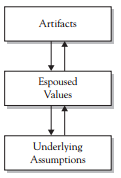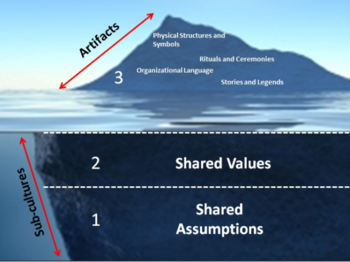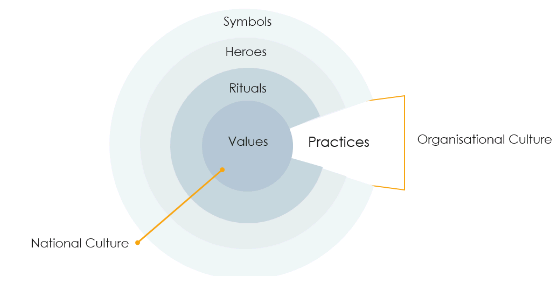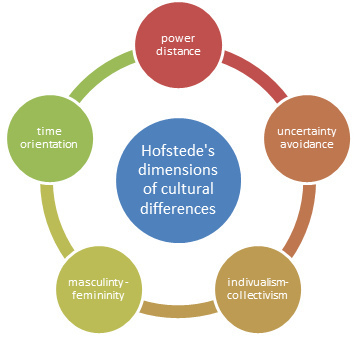Schein's model of organizational culture
The Schein's Model of Organizational Culture is a method which aims at explaining the concept of culture and the way it affects organizations. It is a dynamic model of learning and group dynamics.
It was introduced by Edgar Schein in 1980 in his endeavour to explain why people behave differently in various organizations. He observed that culture is always in the process of formation and change tends to cover all aspects of human functioning. It is also learned around the major issues of external adaptation and internal integration. Finally, it comes to be embodied ultimately as an interrelated, patterned set of basic assumptions which deal with ultimate issues such as the nature of humanity, human relationships, time, space, and the nature of reality and truth itself.
The Schein's Model of Organizational Culture enables organizations to recompose its culture by applying the concepts proposed by the model. It highlights the different levels of each organizational culture and the concepts to take into account.
The culture of a company determines the way the company develop its business, the relation with suppliers, clients and with the final customer. As an example, NovoNordisk claims that it has a creative and supportive culture which motivates its employees to be the best they can. NovoNordisk has defined 10 statements that describe its culture and its way of work in practice. "We create value by having a patient centred business approach" or "We provide innovation to the benefit of our stakeholders" are two examples of the statements that define the culture of the company.
When it comes to doing business, the culture of each company is reflected and it conditions the way that business is conducted. For this reason, the culture of a company is a decisive term in agreements related to projects and programs.
Nowadays, the Schein's Model of Organizational Culture is used extensively in organizations worldwide. It is considered one of the most important project management tools aimed at organizations to determine its mission and vision.
Contents |
The idea behind the method
Normally, the functions of organizational culture manifest itself in two aims. First, creating the feeling of identity among personnel and commitment to the organization. And second, creating a competitive edge to enable the members in the organization to well understand acceptable behaviour and social system stability (Martins, 2000).
It is the fact that organizational culture can offer a shared system of meaning, which forms the basis of communication and mutual understanding. If the organizational culture does not fulfil these functions in a satisfactory way, the culture may significantly reduce the efficiency of an organization (Furnham & Gunter, 1993).
On the other hand, organizations use different resources and processes to guide behaviour and change. Organizational culture is playing an indirect role in influencing behaviour by using reasonable managerial tools, such us strategic direction, goals, tasks, technology, structure, communication, decision making, cooperation and interpersonal relationships, and so forth, which are all designed to do things (Martins & Terblanche, 2003).
Each company has its own culture as a unique identity. Edgar Schein realised that the culture of an organization affects how the people involved in it feel in the organization and how they perform for the organization.
Based on this observation, Schein introduced the Organizational Culture Model. Organizational culture is defined as a pattern of basic assumptions that that a group has invented, discovered or developed in learning to cope with its problems of external adaptation and internal integration. That have worked well enough to be considered valid, and therefore, to be taught to new members as the correct way to perceive, think, and feel in relation to those problems.
One of the concerns Schein had when defining the model was to make understand that culture is more complex than it seems. He thought that it is tempting to say that culture is just the way a company does the things, the company climate and the reward system. He pointed out that all of those are manifestations of the culture, but none is the culture at the level where culture matters.
Culture can be analysed at several different levels, with the term level meaning the degree to which the cultural phenomenon is visible to the observer. These levels range from the very tangible open manifestations that one can see and feel to the deeply embedded, unconscious, basic assumptions defined as the essence of culture. In between these layers are various espoused beliefs, values, norms and rules of behaviour that members of the culture use as a way of depicting the culture to themselves and others.
Three levels in organizational culture
Behaviours and artifacts is the most manifest level of culture, consisting of the constructed physical and social environment of an organization. These mark the surface of the culture and they are the visible elements in the organization. Physical artifacts are presented in the architecture and interior arrangements, physical space and office design. Besides, language gives away culture through modes of speaking, slogans and expressions. Technology is also a part of the culture, since it reflects the values through operations, materials and knowledge. As it also is social practices, leadership practices and work traditions. They can be recognized by people not part of the culture but can be difficult to understand easily by everyone since they can be confusing.
Espoused values is a less visible level than behaviours and artifacts. The constituents of this level of culture provide the underlying meanings and interrelations by which the patterns of behaviours and artifacts may be deciphered. Espoused values are the organization's stated values and rules of behaviours. It is how the members represent the organization both to themselves and to others. This is often expressed in official philosophies and public statements of identity. It can sometimes often be a projection for the future, of what the members hope to become.
Basic underlying assumptions represent and unconscious level of culture, at which the underlying values have, over a period of time, been transformed and are taken for granted as an organizationally acceptable way of perceiving the world. By this definition, basic assumptions are also the most difficult to relearn and change. Besides, the underlying assumptions are often difficult to describe and are only really understood by people who have become accustomed to the way the organization works. Those are usually invisible. They are not written down anywhere and people may not want to talk about them, but they exist and are often powerful.
When basic assumptions are understood, the apparently isolated and confusing artifacts and values become coherent. There are six types of assumptions that form the paradigm for every organization:
1. Assumptions about what is the truth in physical and social matters.
2. Assumptions about the importance of time in a group
3. Assumptions about how space is to be owned and allocated, the symbolic meaning of space around people.
4. Basic assumptions about the intrinsic or ultimate aspects of human nature, whether the human nature is fundamentally good of bad.
5. Assumptions about the organization's relationship with its environment and about the understanding of work.
6. Assumptions about the right way for people to relate with each other, the appropriate ways to distribute power and responsibilities and the appropriate ways of resolving conflicts and making decisions.
The Schein's Organizational Culture Model in practice
The organizational culture model provides a framework with ten steps which let companies to assess its own culture. Those steps should be completed with a group of employees who represents parts of the organization that may be most involved with solving the business problem.
This methodology consists of proposing a business problem the company itself face, to analyse how it would be solved by the group selected.
1. Obtainment leadership commitment: The leader should also emphasize that openness and candour are needed and that culture is not good or bad.
2. Selection of groups for self-assessment: The group of people should be who cut across the levels and functions that are most likely to care about the business problem.
3. Statement of the business problem: Related to concrete areas of improvement, or else the culture analysis may seem pointless and stale.
4. Revision of the concept of culture and its levels: Once the strategic or tactical goals are agreed, a revision of the concept of culture as existing at the three levels of visible artifacts, espoused values, and shared tacit assumptions, has to be done.
5. Identification of artifacts
6. Identification of the organization's espoused values: Sometimes, they have been reiterated as part of the "vision" of how the organization should be operating in the future to remain viable and competitive.
7. Comparison of values with artifacts.
8. Identification of basic underlying assumptions
9. Decision of the next step: Once the steps are completed, there should be sufficient insight to plan the next steps in changing the program and identifying cultural elements that will require culture evolution.
The Iceberg Model
The Iceberg Model is based on the Schein's Organizational Culture Model and includes four other concepts which influence in the way people behave, which are explained in the Cultural Onion Model.
The first concept is Symbols, which are any kind of pictures, objects or words which carry a particular meaning only recognized by the members of one culture. For instance, accent, idioms, clothes, colours..
The second one is 'Heroes, which are role models possessing characteristics that are highly prized in a culture, as for example, politicians or historical people.
Then, Rituals are defined as conventionalized behaviour patterns that are occur un particular situations. For example, business meetings or small-talks.
Finally, the concept of Values is defined as the core of culture. They are taught in early childhood ans most important for one's decision what is right or wrong.
All of these concepts have to be taken into account when defining a corporate culture. Companies have a lot of different nationalities which imply that everyone has different symbols, heroes, rituals and values. Therefore, people react and behave in a different way when facing a situation.
For this reason, it is esential to have a corporate culture which comtemplates these variable concepts and to be consistent on its parameters.
Limitations
1. Imposition of a culture
Morgan (1997, p. 150-51) points out that there may be ethical dilemmas because cultural leadership may be regarded as the imposition of a culture by leaders on other members of the organization. The search for a monoculture may mean subordinating the values and beliefs of some participants to those of leaders of the dominant group.
2. Insecurity of the emergence of a monoculture
The cultural model may be unduly mechanistic, assuming that leaders can determine the culture of the organization. Morgan (1997) states that leaders cannot ensure the emergence of a monoculture despite they have influence over the evolution of culture by espousing desired values.
3. Underestimation of elements
The organizational culture model focuses on symbols such as rituals and ceremonies. That may mean that other elements of organizations are underestimated. Hoyle (1986, p.166) states that symbols may misrepresent the reality of organizations and may go through the appearance of change but the reality continues as before.
5D Theory
The Schein's Model of Organizational Culture might result quite general for the implementation on companies. So, a new model was created to complement the former. Hofstede extracted four dimensions used to explain the cultural diversity in the world.
Managing people is difficult when everybody does not share a common personal culture. There is not a common general understanding of what is "right" and what is "wrong", what is "accepted behaviour" and what is considered "inappropriate" or "unacceptable". When people in the team have different cultural backgrounds, or the manager's background differs from the team's, that is when serious misunderstanding can arise.
To explain the factors that can influence to determine a culture, Hofstede (2003) proposed a theory in which he found 5 fundamental value dimensions.
1. Power Distance (PDI) is the degree to which people accept and expect that power is distributed unevenly within a company.
2. Individualism (IDV) is the degree to which taking responsibility for yourself is more valued rather than belonging to a group, who will look after their people in exchange for loyalty.
3. Masculinity (MAS) is the degree to which people value performance and status deriving from it rather than quality of life and caring for others.
4. Uncertainty Avoidance (UAI) is the degree to which people develop mechanisms to avoid uncertainty.
5. Long-Term Orientation (LTO) is the degree to which people value long-term goals and have a pragmatic approach, rather than being normative and short-term oriented.
This model explains five factors which are not considered in the Schein's Model of Organizational Culture. The latter assumes that the culture of a company is invariable and rigid but, the 5D model points out some factors which might difficult the one-culture point of view of companies.



